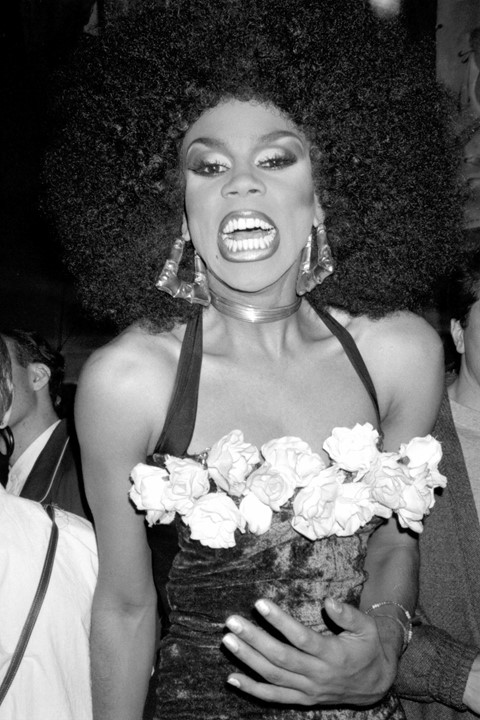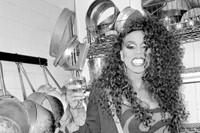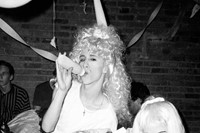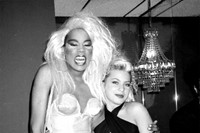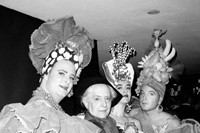The work of photographer John Simone, exhibited at RuPaul’s DragCon LA this weekend, shows a drag queen among the energy and creativity of New York’s 1980s club scene
It’s likely you’ve already seen a John Simone photograph. Black and white, covered with grit, bulbs flashing onto the greatest queer icons the earth has ever known, catching them in all sorts of acts before fame rewarded people who lived on the fringes of society (even though they were famous on the New York club scene). “They were like the bastard children of John Waters movies, of which they knew all the dialogue. Every night was another fashion triumph or disaster, both worthy of documenting,” he tells Another Man.
Simone moved to New York in 1987, and after showing his contact sheets to Stephen Saban – nightlife editor at the legendary Details magazine – he became the photographer who would capture the rising stars of every legendary New York night, from Studio 54 to the Roxy. Think: David Bowie, Divine, Grace Jones, Keith Haring, Liza, Jayne County, Bianca Jagger, RuPaul, Lypsinka, Lady Bunny – and you’re about halfway there. “In nightlife,” Simone explains, “it’s easy to have countless muses. They were the ones that always presented. They expected to be photographed and came ready for it. RuPaul was always memorable to shoot because even if she spent just ten minutes to whip a look together she would exude for the camera. She always ‘werked’ it.”
RuPaul: Evolution of an Icon is his new exhibition, which appeared at DragCon from May 24 to 26. “When I put three years of RuPaul photos in chronological order,” Simone adds, “they reveal her changing style, new wigs donned, old gone, looking a little punk and trashy and then progressing to a more couture look. In 30 years RuPaul has developed from a go-go-dancing drag queen to an international brand, with three Emmy Awards and a new talk show debuting on June 10. That’s evidence of a highly evolved individual.”
Another Man caught up with Simone about the upcoming exhibition, what New York felt like back then, and how things have changed for those who capture the nightlife scene. His is an archive from right in the thick of it, one which keeps the spirit of a time alive: “So many superstars from the 80s downtown scene are not alive today,” Simone says, “like John Sex and Dean Johnson. My work is a testament to a New York in which they existed and where their fabulousness is preserved and celebrated.”

Tom Rasmussen: Why were you drawn to photograph the New York drag and nightlife scenes?
John Simone: New York was always a symbol of creativity and outrageousness to me. I discovered that side of the city in the original Details magazine. Co-founder and nightlife editor Stephen Saban showcased the famous alongside the freaks, the drag queens and the fabulous nobodies while exposing the newest in art, fashion and the downtown culture of New York. I knew I wanted to move to New York and be a part of that scene.
TR: What did New York feel like at the time?
JS: People say that New York was much more real then. They mean it was dirty, smelly and ugly. But actually, most of New York was quite middle class… I lived in Midtown East in Turtle Bay and in Rosehill and it was safe and charming. Many clubs were in the Chelsea warehouse district like 1018 and the Tunnel, where the High Line is now, which was totally safe. Then you had the fabulous and grungy dumps like the World down on Avenue C and Houston, where you did not linger outside the club if you cared to live for long. Politically it was a war zone, with AIDS activists marching and protesting for their and our lives; socially it was a disaster with a severe drug and homelessness crisis and then the stock market crashed. But the party never stopped.
Promoters like Susanne Bartsch and the club kids brought new energy and creativity to the scene. It was cool to go out and dress up again. The original club kids, the ones in my photos, like Really Denise, Goldyloxxx and Kenny Kenny were not the drug-fuelled club goers of the 90s. They were fashion, design and art students who studied at FIT, Parson’s and Pratt. They may have stayed out to 5am but I’m sure they did their homework.
TR: How do you think that scene has changed from a photographer’s perspective?
JS: In the late 80s, I might’ve been the only photographer at some of these clubs. Today, every person is taking photographs. Will we be looking at them in 30 years? The scene today has many times the number of fabulous people that existed in the 80s. Drag queens have taken over the world. I hope they are getting the same attention that I gave their predecessors. Celebrities were much more accessible in the 80s in New York clubs. They did not have to travel with a security force. It was before bottle service wrecked the vibe of New York clubs which made the scene more about the money and less about the creativity.
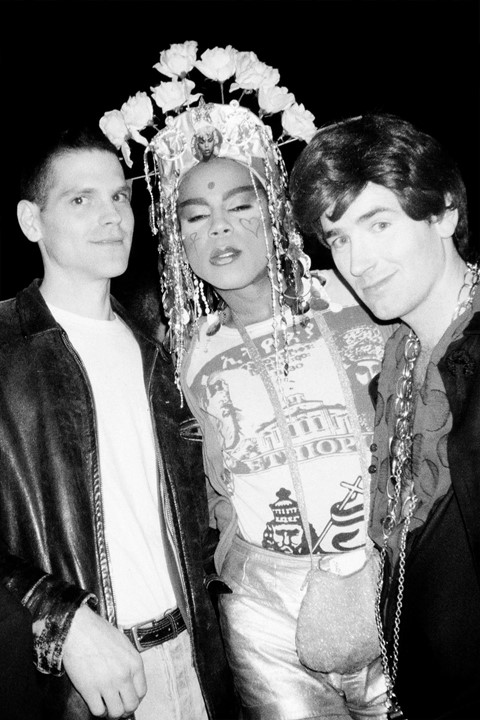
TR: Was there a particular moment you knew these people you were shooting were becoming icons? If so, how did you know?
JS: The second you meet Leigh Bowery, Sister Dimension, RuPaul or Lady Bunny, you know you are dealing with a self-created ‘masterpiece’. The East Village drag queens of the Pyramid club and the club kids at the Tunnel challenged mainstream culture.
TR: Which image do you think most sums up your relationship as a photographer with RuPaul?
JS: That would be RuPaul with Pots and Pans, taken in the kitchen of MK club, the night I hired her to perform House of Love at a birthday bash for Marlon de la Ungaro Xtravaganza, the first white person adopted into the legendary House of Xtravaganza. All the Xtravaganza kids that were in the voguing movie Paris is Burning.
TR: Why is DragCon the perfect place for this exhibition?
JS: With 40,000 RuPaul and Drag Race fans in attendance, there is no better place in the universe for my RuPaul photographs. I wanted to do LA DragCon earlier, but I was not ready to present my work to the world until I had scanned and restored the first phase of 2,000 shots from my files and then process them for my site. Now people I meet at DragCon and online can discover this work in what I call my ‘80s New York Nightlife Photocyclopedia’. My RuPaul images reveal that she was a star from the very beginning. She knew it, and New York knew it and people responded to her unique star quality. I see it in my photos. And now the world has responded to RuPaul in kind.
In 1988 she was the third crowned Queen of Downtown in Michael Alig’s annual rigged pageant, after the title had been first Lady Bunny’s and Sister Dimension’s. That is truly a sign of pre-ordained greatness!
